
Create your own journey; Experience the best of Northern Spain at your own pace
This website uses its own and third-party cookies, for the proper functioning of the site and to generate usage statistics.
By continuing to browse we understand that you consent to our �ookie policy
Embark on an epic adventure on the French Camino de Santiago, a 750+ km journey starting from Saint-Jean-Pied-de-Port. This Camino is perfectly suited for most pilgrims, thanks to its moderate difficulty level.
Traverse through historic cities like Pamplona, León, and Burgos, cross the vast plateaus of Castilla y León, and be awed by the lush green hills of Galicia, all leading up to the majestic Cathedral of Santiago. This route is a fusion of physical challenge and cultural discovery, offering breathtaking landscapes, a rich historical tapestry, iconic monuments, and exquisite local cuisine. While certain segments are challenging, they enhance the rewarding experience of this remarkable pilgrimage.
Click here to explore the Camino Francés:
Find key insights on distances, terrain, climate, and vital tips.
Click on Request now (on the right column) and receive a personalized offer for your trip with no binding commitment.
✔ Daily departures all year round.
✔ Carefully selected hotels, always with private bathrooms.
✔ Possibility of dividing the stages: Yes, almost always.
✔ Take a deeper look at the beautiful cities of: Pamplona, Logroño, Burgos, and León. We recommend that you add an extra night at each of these places.
✔ Visiting the Monasteries of Yuso and Suso, declared a UNESCO World Heritage Site in 1997. For this, you'll need an extra night in either Nájera or Santo Domingo de la Calzada.
✔ Monastery of Samos. You can add an extra night here.
✔ Roman Wall in Lugo. You'll need an extra night in Sarria.
✔ Spending the day in Ribera Sacra to see the vineyards and take a beautiful cruise on the Sil River. You'll need an extra night in Sarria.
![]()
Click here to explore the Camino Francés:
Find key insights on distances, terrain, climate, and vital tips.
Camino de Santiago: THE WHOLE French Way
(SJPDP - Santiago)
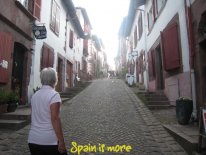
St. Jean Pied de Port is often considered the official starting point for the Camino de Santiago, and this idyllic French village is also the ideal place to start your camino as it offers good food and a pleasant and peaceful atmosphere. Here you will find French village charm, history, monuments and good restaurants in abundant quantities.
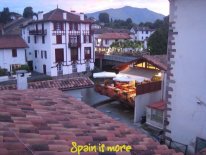
St. Jean Pied de Port is considered the official starting point for the Camino de Santiago. This idyllic French village is also the perfect place to start your Camino, as it offers good food in a pleasant and peaceful atmosphere. Here you will find French village charm, history, monuments and good restaurants in abundance.
St. Jean Pied de Port is located at the foot of the Pyrenees, which makes the location unique, but the mountains also account for a significant challenge on the Camino as they have to be crossed in order to continue the journey. The first stage is one of the most beautiful on the whole Camino, yet certainly the toughest, without the possibility of shortening this stage.
If approximately 18 kilometers of hard climb sounds like a lot, we can arrange transportation for the first 10 kilometers – which are the toughest – or all the way to Roncesvalles (you may also begin your walk in Roncesvalles, which will result in a price reduction of approximately 50€/person).
The benefits of starting in St. Jean Pied de Port are: 1. The city is well worth a visit. 2. This stage is immensely beautiful. 3. By starting here, you will experience the Camino from the start. 4. Last, but not least, the hardest stage is already over on the first day.
See Timelap of the stage here.
Distance: 24 Km
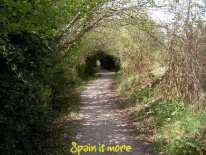
Roncesvalles is a widely used starting point for pilgrims on the Camino de Santiago since the route from here is a bit easier than the previous one, as it primarily descends towards Pamplona.
However, the terrain is still very hilly and relatively hard. Nonetheless, you will walk through a series of idyllic and very well-maintained villages, some of the most beautiful villages you will experience throughout the trip, as well as forested hills that provide shade and wonderful ambiance. There are several small, but tough ascents along the way but, generally your hike will descend 400 meters this day.
Distance: 21 Km
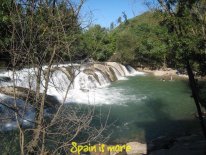
During most of the day, this stage follows the Arga River but despite this, you have to climb some hilltops. The stage also passes through a large number of small villages as Pamplona's suburbs are beginning to appear. Before being rewarded with Pamplona's old district, you will have to successfully complete the climb towards the city center.
In return, you will experience Pamplona’s atmosphere-filled center, which is one of Spain's most attractive. Pamplona is famous for its tapas and pinchos. In the accompanying guidebook we give you our recommendations for the best places, so you can experience Pamplona in just the right way. If you want more time to explore and enjoy the city, an extra night is certainly recommendable.
Note: If you want to stay in Pamplona during the Sanfermines festival from the 6th to the 17th of July each year, the price will be significantly higher. In addition, it’s necessary to book at least eight months in advance during this period.
Distance: 20 Km
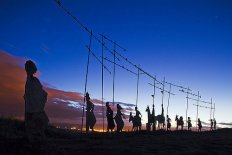
Climbing Mount Alto del Perdón (see picture) is the biggest obstacle on this day, but if the climb seems too hard, will you discover a recommendable detour in our guidebook. However, despite the difficulty we recommend the climb, because from the top you will have a spectacular view of Pamplona and the Pyrenees in one direction and a view of the easier upcoming stages of the route in the other. Today's stage ends in Puente de la Reina, which has a beautiful old town and a famous bridge from where the Camino heads west (The Queens bridge, Puente de la Reina).
Distance: 24 Km
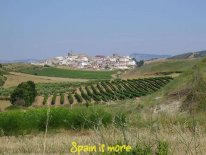
A few minor but steep hills bring you to Estella. Especially during the early part of this stage you will pass through many vineyards. It's recommendable to take the several opportunities to visit some of them and in this way also enjoy a little rest along the way.
Distance: 22 Km
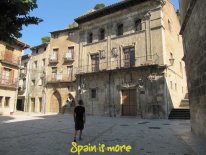
Estella is a history-rich and exciting city with a beautiful old town.
Today's stage begins with a relatively gentle ascent and continues into flat and easy walking as you travel. There are several wineries along the way which can be visited, with a few of them also serving as excellent restaurants.
There’s not much shade available at this stage, so if you walk in the summer or on a sunny day it advisable to get an early start. Torres del Rio is situated on a hilltop and has a nice old town in which to relax and explore.
Distance: 23 Km
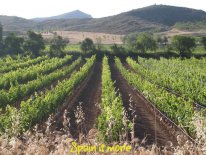
This is a flat and easy stage compared to everything you've experienced so far. You will pass several historical villages along the Camino. You will begin to be surrounded by vineyards, a sign that welcomes you to Logroño and La Rioja.
Logroño is La Rioja's largest city and, of course, the center of many of the Rioja wineries. Besides an excellent glass of wine for which Logroño is so well-known, is also its great cuisine. In the city's well-preserved old town center there are also countless delicious tapas bars.
Distance: 26 Km
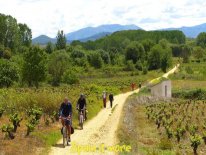
The parks and natural environment of the Grajera Reservoir top off the stay in Logroño and open the doors to the incredible Rioja landscape, filled with vineyards and orchards filled with fruit trees.
This stage takes you to Nájera, passing through Navarrete, a town celebrated for its traditional pottery. Later you walk on to Ventosa and the heights of San Antón. These hills offer views of unending rows of vineyards, a beautiful sight especially in September when harvest has reached its peak.
Distance: 29 Km
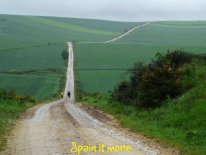
Today the goal is Santo Domingo de la Calzada, a town in Rioja Alta. The route passes through the charming town of Azofra.
In this segment, due to its proximity to Castilla, the landscape is rich with abundant fields of grain. Moreover, Santo Domingo itself is a vibrant town. There are many restaurants with delicious food and a very well preserved city centre that attract tourists all year round.
Distance: 21 Km
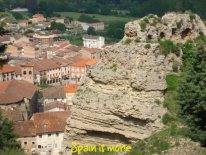
Today the Camino enters Castilla y León. From now on, and for a couple of weeks, you will pass through the widened passages of the “Meseta Castellana,” the Castillian plateau. The next closest objective is Belorado, located in the shade of a peak where ancient hermit caves and the ruins of a mythical Castle still remain.
Distance: 21 Km
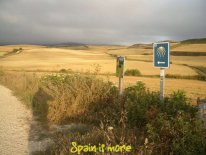
The following stage passes through several interesting monuments such as the Virgen de la Peña Church, carved out of the rock as well as some nicely located castle ruins.
This part of the journey passes through hillside landscapes and extensive forests (the last before reaching León, and if you have chosen to continue walking from Leon to Santiago, you will not see true forests for approximately 300 km.).
Distance: 25 Km
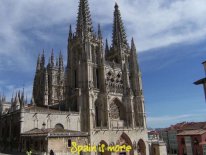
The first leg of the trip passes through a small pine forest before seeing the outskirts of Burgos.
Burgos was founded in the year 884 and its heritage shines with its own light. The city is filled with monuments that include its crowned jewel, an amazing gothic cathedral. In fact, the cathedral of Burgos became a UNESCO World Heritage Site in 1984. Overall, Burgos gives off a medieval feeling, a sensation completed by its inviting tapas bars.
Distance: 26 Km
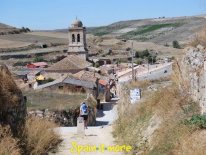
Today you enter the unpopulated plateau where you only be accompanied by your own shadow and if you're lucky, some other pilgrim that you find along the Camino. You will discover scenery and almost medieval towns that have become embedded in the legend of the Camino since its beginning.
Distance: 31 Km
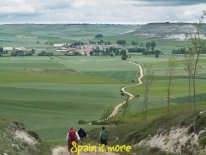
This day, without tree coverage from the elements - be it the summer sun, the penetrating winter cold or the uncomfortable wind - what will stay etched in your mind will be the walk under the arches of San Antón, the visit to the Castrojeriz and the later climb to the Teso de Mostelares. From this hill the extensive "Tierra de Campos" opens up to the pilgrim, a region proud of its grain, pigeon flocks and valuable art.
NOTE: The stages of today and tomorrow can be divided in 3 if the distance seemss too long to you.
Distance: 32 Km
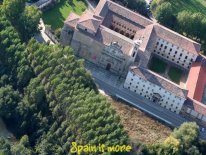
In this stage the flatness of the land and monotony of a walk take over as the walker passes through the nucleus of the countryside. In the final leg you will find yourself in Santa María la Blanca Church- a stronghold attributed to the Templars.
Distance: 19 Km
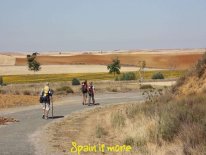
Today you can visit "Monesterio de San Zoilo" that is found on the outskirts of Carrión de los Condes (if you reserve your trip enough in advance it is possible to stay the night at the monastery).
Distance: 28 Km
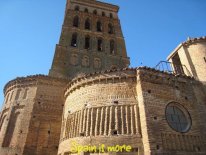
The route continues through unending fields until you reach Sahagún, an important pilgrimage stop, with points of interest like monasteries, churches and a fantastic Roman bridge.
Grain, corn, sunflowers and numerous other crops provide striking color during this flat stage. Although initially the general scenery may appear a little boring, be sure to be on the look out as this is a wonderful place to see eagles and storks and much more. The route passes through several typical towns that probably wouldn't exist if it weren't for El Camino.
Distance: 25 Km
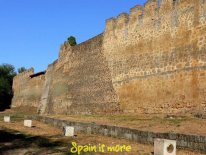
Today a tree lined path will take you to Reliegos y Mansilla. On the way you will see many cellars that appear as caves carved out of the hills. These were traditionally used to mature the wine, but today these traditional cellars are far from modern wine manufacturing, hence many of them are now used for restaurants or private gatherings places where friends and family meet. Examples of this are found in the small town of Reliegos.
Distance: 19 Km
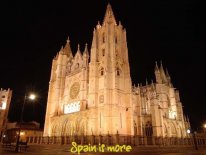
Today you will arrive in León. The first few kilometres after Mansilla are fairly nice although later they are followed by a walk throughthe industrial area of León (for which reason some chose to take the bus at this point).
Once you have reached Leon, and catch your first sight of the Cathedral you will know that every step of the journey so far has been worth it.
This old Roman capital is one of the main towns of the pilgrimage. In 910 León was the capital of the kingdom that later became the Spain, the country, that we know today. The medieval importance of this city is reflected in numerous monuments such as the Cathedral, San Marcos and the Basilica San Isidoro where several kings of historical importance are buried and where the much sought after Holy Grail is believed by many historians to be housed.
The town is filled with tapas bars and inviting places and observe sore-footed pilgrims walking around with the hope of finally reaching Santiago during this journey or the next.
Distance: 19 Km
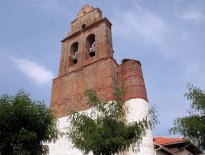
Passing by way of the lovely Roman bridge in front of the Parador Hostal de San Marcos, you leave León. The first 8km pass through the industrial zone of León, and from here the road continues along the main highway. Fortunately, there is a much more tranquil and pretty path that Spain is More will show you. Once you´ve passed the industrial zone, exiting León, you will take this alternative route for the next 15km until Villar de Mazarife, where you will sleep.
Distance: 22 Km
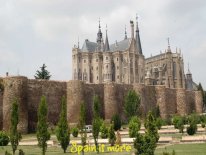
The most stunning point of this stage is when you find yourself with the Roman bridge in Hospital de Órbigo. In general it´s a calm and easy stretch with various miradores (vista points) from which you can see the striking mountains over which you will be trekking during the next few days.
Astorga, a 2000 year old walled Roman capital of one of the olded and extensive diocese in Spain, is crossed by the Camino Francés and Camino del Sur or Vía de la Plata. Worth the visit: Gaudi´s Bishop´s Palace, The Chocolate Museum, The Roman Route, The Roman Museum and all the city´s historic quarters.
Distance: 31 Km
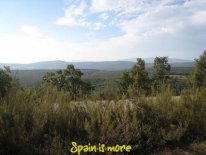
A few kilometers after Astorga the landscape begins to change and becomes more mountainous. Before arriving to today´s destination you will pass through more beautiful, charming towns such as Castillo de los Polvazares that truly deserve a visit. Rabanal is a welcoming town with a great deal of pilgrim ambiance.
Distance: 21 Km
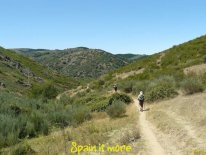
This stage through the mountains is unforgettable because you'll reach the famous Iron Cross (Cruz de Ferro) where pilgrims traditionally leave a stones representing a burden or desire and carried from their home towns at the base of the cross. Next, along the way to Molinaseca, the wondrous natural scenery is marked by a few villages. Molinaseca is crammed with charming restaurants frequented by pilgrims and locals alike, all enjoying the city’s picturesque streets and cozy cafés.
Distance: 27 Km
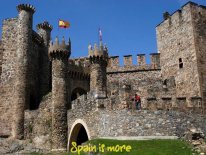
Today you pass through Ponferrada, the city with a famous 12th-century Templar castle, Castillo de los Templarios, at the town center. Ponferrada is a large mining city with a population of over 60.000 and an important stop on the Camino. As you leave, you´ll pass through Cacabelos, a small medieval stop for pilgrims, today home for a large number of wine-cellars (bodegas). Then, it’s on to Villafranca del Bierzo, often known as the “other” or “little” Santiago. Notice the 12th century Romanesque Church of Santiago and its north entrance, Door of Forgiveness. Villafranca del Bierzo is one of the most pleasant Camino towns found in the middle of Bierzo, which has established itself as one of Spain’s greatest wine regions.
Distance: 29 Km
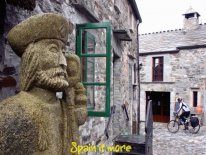
Today, in the region bordering Galicia, you'll walk along ancient paths shaded by birches, oaks, chestnuts and poplars up to the emblematic mountaintop village of O’Cebreiro. There is a lovely 12th century Romanesque church with a fascinating legend, and curious old straw-roofed dwellings called Pallozas. This path offers some of the most panoramic views, but is also one of the toughest stages. Often shrouded in mist, the small stone village is extremely charming. If you arrive on a clear day, the views are dazzling!
Its possible to split this stage in two.
Distance: 28 Km
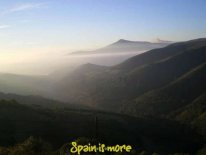
After a lot of uphill on one of the highest points of the trip, O Cebreiro, today will mostly be downhill. Once again, you´ll have many splendid views of the surrounding countryside. Today you'll also begin to notice stone granaries called "horreos". Also, the weather will change a bit, due to the winds and rain from the Atlantic Ocean. Although none of the castles still exist today, the name Triacastela, meaning "three castles," carries on. Limestone used to build the Cathedral de Santiago came from quarries near Triacastela.
Distance: 21 Km
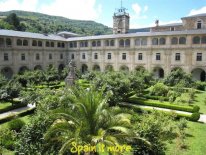
The landscape begins to change as you begin the descent, perhaps a welcome relief after the last few days of hilly terrain. The route to Sarria give you the choice of two paths, one in a couple of hours allows a recommendable visit to the Benedictine Monastery of Samos, founded in the 6th century and one of the oldest in western Christendom. From here its a idyllic hike through the forrest to Sarria. The other route is a quicker way to reach the end.
Sarria itself is a town of about 13,000 residents and is the last place pilgrims with limited time can hike the minimum distance to the Cathedral de Santiago, 100 km, to receive their Certificate of Completion on the Camino. Because of this, Sarria is a major starting point for many pilgrims. You’ll notice an increased number of fellow pilgrims from here to Santiago.
Distance: 18 Km
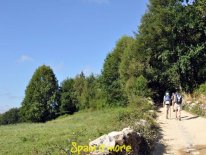
Galicia is one of the most beautiful regions in Spain, both in nature and glorious tradition. Today’s walk is one of the most attractive stages of the entire Pilgrim’s Way; traveling through authentic rural Spain and its verdant forests, grassy meadows, fertile orchards and simple stone-built hamlets.
Distance: 23 Km
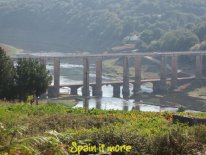
The terrain becomes flatter, though still hilly. Optimism takes over in this magnificent, lush area. By now your goal feels achievable. The journey continues along farm tracks and quiet country roads through the lush Galician countryside to Palas de Rei. Palas de Rei is a small village of around 2,000, with an illustrious past, although nothing remains today as a reminder since the historic city was engulfed in 1960 with the water from the dam and lake that were built.
NOTE: the two stages between Portomarin and Arzúa can be divided into three stages with the following km. distribution: 17, 16 and 20 km.
Distance: 25 Km
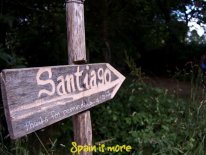
Today's views will seem somewhat familiar. A typical day on the Camino de Santiago, through rolling green landscapes, dotted with cows, stone walls and tiny Romanesque churches. Take time to talk and learn about myriad of legends and stories that this route offers. Today´s stage can also be divided into an extra night in Melide.
NOTE: the two stages between Portomarin and Arzúa can be divided into three stages with the following km. distribution: 17, 16 and 20 km. Or we can just divide the long stange between Palas de Rei and Arzua in two stages.
Distance: 28 Km
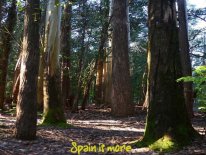
An exhilarating atmosphere unfolds as your journey's end draws closer. Pilgrims now feel the close joy of having reached their goal and they begin to revel in happiness and relief with the many companions they met along the way. Today’s walk is along natural pathways through tall groves of Eucalyptus that provide superb shade during your walk.
Distance: 20 Km
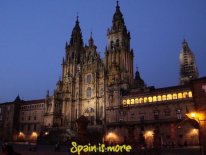
Congratulations, you achieved an admirable goal, so it's time for a number of traditional pilgrimage rituals. First, be sure to get proof of this feat: the last stamp in your pilgrim passport.
Along with the rituals, enjoy the End Station of the Pilgrim Route, Santiago de Compostela, which offers a veritable cornucopia of attractions and one of the world’s most important cultural centers. This university town exudes charm and has a myriad of cozy streets offering ample opportunity to sample the many local delicacies.
The Cathedral is surrounded by a historic center which is on UNESCO’s World Heritage Site list, and its old town is incomparable to any other. Its monuments stand as true works of art in different architectural styles.
Distance: 20 Km
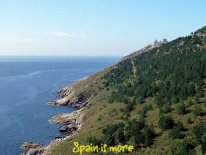
True pilgrims continues further and finish their journeys in Finisterre. The tour goes by bus with an English-speaking guide from Santiago to Finisterre in the morning and returns to Santiago in the late afternoon. Just off the stunning, rugged coastline and the fabled “Costa de la Muerte” (Death Coast), a reef filled with shipwrecks and tales of legends captures a raw, natural beauty. On the coast’s westernmost point is Finisterre – meaning the world’s end. Romans named this coast because it was literally the end of the known world. For many pilgrims this is the symbolic endpoint of the pilgrimage.
The evening is spent in Santiago de Compostela.
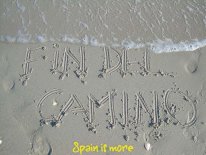
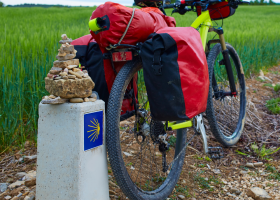
Pilgrimage by bike through incredible landscapes
9 days / 8 nights
From 850 EUR/pers.
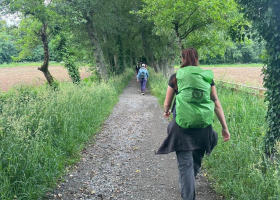
Pilgrimage along the last 116 km from Sarria to Santiago.
8 days / 7 nights
From 550 EUR/pers.

The last 2 weeks of Camino del Norte from Avilés to Santiago; Amidst Greenery and Sea.
17 days / 16 nights.
From 990 EUR/pers.
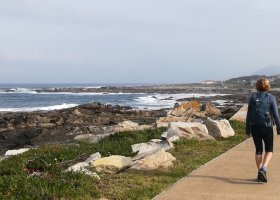
Pilgrimage along the St. James Way from Porto to Santiago along the coast.
16 days / 15 nights
From 1200 Euro/pers.
The Iron Cross in Foncebadón: A Pilgrim's Symbol of Transformation
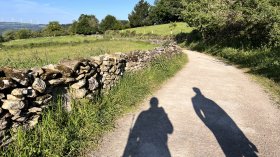
Walk and Talk is not only effective as a meeting format at your workplace. Book a Camino journey and experience a new way of expressing yourself with the help of the nature...